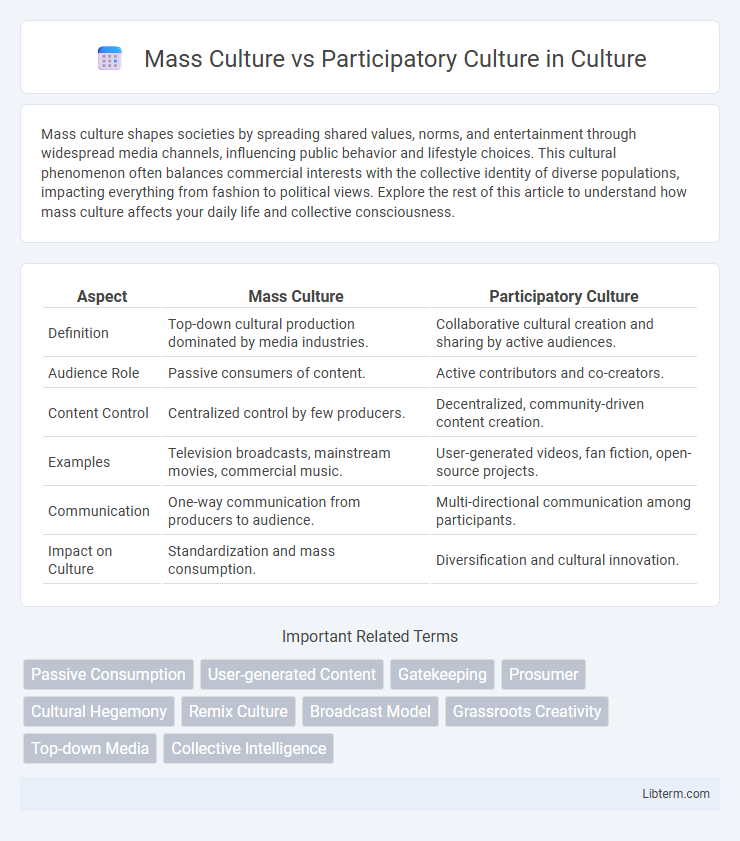Mass culture shapes societies by spreading shared values, norms, and entertainment through widespread media channels, influencing public behavior and lifestyle choices. This cultural phenomenon often balances commercial interests with the collective identity of diverse populations, impacting everything from fashion to political views. Explore the rest of this article to understand how mass culture affects your daily life and collective consciousness.
Table of Comparison
| Aspect | Mass Culture | Participatory Culture |
|---|---|---|
| Definition | Top-down cultural production dominated by media industries. | Collaborative cultural creation and sharing by active audiences. |
| Audience Role | Passive consumers of content. | Active contributors and co-creators. |
| Content Control | Centralized control by few producers. | Decentralized, community-driven content creation. |
| Examples | Television broadcasts, mainstream movies, commercial music. | User-generated videos, fan fiction, open-source projects. |
| Communication | One-way communication from producers to audience. | Multi-directional communication among participants. |
| Impact on Culture | Standardization and mass consumption. | Diversification and cultural innovation. |
Defining Mass Culture and Participatory Culture
Mass culture refers to a set of ideas, values, and practices produced and consumed by large, passive audiences through mass media channels like television, radio, and print, often characterized by standardized content and commercial objectives. Participatory culture emphasizes active engagement, collaboration, and content creation by individuals or communities who contribute to media and cultural productions through digital platforms, social media, and grassroots initiatives. Defining mass culture centers on top-down distribution and uniform consumption, whereas participatory culture highlights bottom-up interaction and shared cultural authorship.
Historical Evolution of Cultural Production
Mass culture emerged during the industrial revolution as large-scale production and mass media centralized cultural content, emphasizing passive consumption. Participatory culture evolved with advancements in digital technology and the internet, enabling individuals to actively create, share, and influence cultural products. This shift transformed cultural production from top-down dissemination to a decentralized, interactive process driven by communities and user-generated content.
Key Characteristics of Mass Culture
Mass culture is characterized by standardized, commercially produced content consumed passively by large audiences, emphasizing uniformity and mass appeal. It often involves top-down communication where media conglomerates control production and distribution, limiting individual creativity and audience participation. The key features include homogenization of cultural products, widespread accessibility, and a focus on entertainment and consumerism.
Core Features of Participatory Culture
Participatory culture is characterized by low barriers to artistic expression and civic engagement, strong support for creating and sharing creations, and informal mentorship where experienced members guide novices. It emphasizes community involvement, collective intelligence, and active contribution rather than passive consumption found in mass culture. These core features foster empowerment, collaboration, and a sense of belonging among participants in digital and social media environments.
Media Technologies Shaping Both Cultures
Mass culture is shaped by centralized media technologies such as television, radio, and print, which deliver uniform content to passive audiences on a large scale. Participatory culture emerges through digital media technologies like social networks, blogs, and streaming platforms that enable users to create, share, and interact with content actively. These contrasting media infrastructures influence cultural production by either reinforcing top-down dissemination or encouraging decentralized collaboration and user engagement.
Power Dynamics: Producers vs. Participants
Mass culture centralizes power with producers who control content creation and distribution, shaping societal narratives and audience consumption patterns. Participatory culture redistributes power by enabling participants to co-create, remix, and influence media, fostering collaborative engagement and democratizing cultural production. This shift challenges traditional hierarchies, allowing consumers to become active contributors rather than passive receivers, altering the dynamics of media influence and authority.
Impacts on Creative Expression and Diversity
Mass culture often centralizes creative expression through mainstream media, resulting in homogenized content with limited diversity, as commercial interests prioritize wide appeal and uniformity. Participatory culture empowers individuals to actively contribute and share their creative works via digital platforms, fostering diverse voices and more varied artistic expressions. This shift enhances cultural representation, democratizes content creation, and expands the range of narratives available in the public sphere.
Social Implications and Community Building
Mass culture often leads to passive consumption with limited audience interaction, reinforcing hierarchical power structures and homogenizing experiences across large populations. Participatory culture fosters active engagement and collaboration, enabling diverse communities to co-create content and share knowledge, which strengthens social bonds and empowers marginalized voices. This shift promotes inclusivity and collective identity, reshaping community building through decentralized networks and democratized communication channels.
Challenges and Criticisms of Both Models
Mass culture faces criticism for promoting passive consumption and homogenization of cultural products, leading to diminished individual creativity and critical engagement. Participatory culture, while encouraging active involvement and collaboration, encounters challenges related to digital divides, content quality control, and potential exploitation of user-generated content. Balancing commercial interests with authentic community participation remains a significant hurdle in both models.
The Future: Convergence or Divergence?
Mass culture, characterized by passive consumption of standardized media, faces challenges from the rise of participatory culture that emphasizes user-generated content and active audience engagement. The future likely involves convergence where traditional media corporations integrate interactive platforms, blending mass reach with personalized participation through technologies like social media and virtual reality. However, divergent trends may persist as digital divides and cultural differences influence access and participation levels globally.
Mass Culture Infographic

 libterm.com
libterm.com